(单词翻译:单击)
Food and nutrition are my burgeoning hobby interests, and recently I compiled some thoughts and articles into this:
食物和营养是我近来非常感兴趣的主题,我汇集了一些想法,写成了如下的文章:
There's something to be said for eating fermented cabbage with spicy pepper paste and vinegar. At least, that's what they say in Korea. Sound appealing? Judging from the amount of elementary school kids who show up to class with red flecks of leftover lunch in their teeth, it must be tasty, too. Can you imagine an 8-year-old American kid listing kimchi, spaghetti, and rice as his favorite food choices?
说到吃一种含有辣椒酱和醋的,发酵过的白菜的食物,是值得一谈的。至少,这种食品在韩国就是这样表述的。听起来挺诱惑的是吗?从齿间还挂着红色的残饭就出现在教室里的小学生们的数量来判断,那食品一定是挺好吃的。你能想象一个8岁大的美国孩子把泡菜、意大利细面、米饭列为他的最爱之食品吗?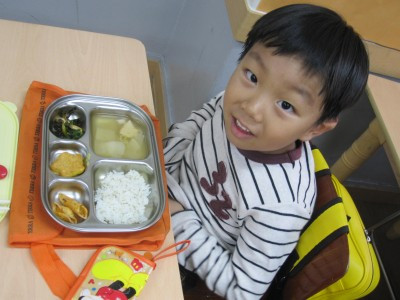
Eric was excited to each a generous serving of sticky white rice, one chicken nugget, odeng, and a small serving of green kimchi with seaweed as well as noodles with meat sauce.
Eric对于足量供应的黏米饭、一份鸡块、鱼饼汤、一小份附有海带和肉酱面的绿色泡菜感到开心。
A northern Illinois native, I've been teaching at a private English academy in Seoul, South Korea for over a year. Although elementary/middle school children don't attend until after their morning of public school, the preschool and kindergarten students attend full time and receive lunch at the academy. For almost my entire first year, I ate alongside the other teachers and students and learned much about typical Korean cuisine and nutrition. Since discovering Mrs. Q.'s blog last Fall, it's been fascinating to compare food and educational experiences across cultures.
作为一个北伊诺斯州人,我在韩国首尔的初级英语学院教学已经有一年了。尽管中小学生在公立学校中上完早上的才来参加,但是来自学前班和幼儿园的学生全天都在学院里并且午饭也再学院里吃。在我的第一年中的大多数时间,我都和别的老师和学生一起吃饭并且学到了很多关于典型韩国人的烹饪方法和营养学。自从去年秋天发现了Q女士的博客,我就陶醉于比较两种不同文化之间的实物和教育经验
My academy has hired lunch through two different caterers and it always consists of rice and at least one type of kimchi or stewed radish, among various side dishes. Kimchi is the traditional dish of Korea, and can take on a variety of appearances and flavors. The main ingredients are cabbage, which is fermented in large pots, and spicy pepper seasoning.
我的学院中的午饭是由两个不同的承包人来准备的,在各种各样的菜中总是有米饭和至少一种泡菜或着炖萝卜。泡菜是韩国传统的食物,它可以搭配各种佐料,也可以各种不同的形式呈现。泡菜的主要原料是卷心菜,人们把卷心菜放在坛子里,然后用辣椒给它调味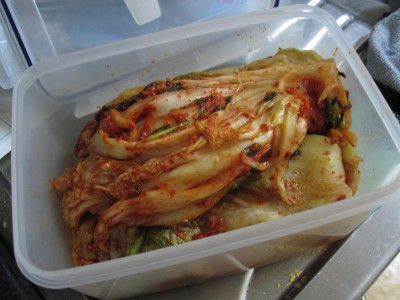
Homemade kimchi, gifted to me by a student. I didn't eat all of it, but I did enjoy servings on occasion until my ultra-cold refrigerator frosted it over!
自制的泡菜,这是一个学生给我的礼物。我没有把所有的都吃完,但我真的喜欢偶尔吃吃,直到我的超低温冰箱给它蒙上了一层霜。
Additional lunchtime side dishes at my academy include ddeok (squishy gluttenous rice-flour cakes covered in varying sauces), fish or meat (always a small amount, seemingly only used to flavor the sticky white rice), egg-squid mini pancakes, seaweed or another thin soup (usually fish or seaweed), spicy squid, anchovies, fruit or cherry tomatoes, and perhaps shot-sized yogurt drinks for dessert. I find it incredibly strange that they eat ddeok with rice, since it's essentially the same. Soy-marinated hardboiled quail eggs, dried seaweed, brown roots, and mushroom concoctions are some of my personal favorites. Potatoes and bread aren't often eaten as part of main courses. Potatoes are sometimes eaten roasted or boiled and whole as an on-the-go snack. Bead is most often served with coffee, or sometimes my kids eat small sweet buns for breakfast.
在我的学院里额外的午餐配菜包括炒年糕(粘糊糊的被蘸上各种酱汁的用米粉做的糕点),鱼或肉(总是少量,看起来只用于给粘米饭调味),鸡蛋鱿鱼小煎饼,海带汤或另一种淡汤(通常是鱼或海带),辣鱿鱼、凤尾鱼、水果或圣女果,也许还有搭配甜点的少量的酸奶。他们炒年糕和米饭一起吃,我觉得这非常奇怪,因为两者本质上是一样的。卤水鹌鹑蛋、干海带、 褐根和蘑菇的混合物是我本人相当喜欢的。土豆和面包不经常作为主食的一部分。土豆有时烤着或煮着吃,或者整个作为随身携带的零食。面包通常来说搭配咖啡一起吃,有时我的孩子们也会吃小甜面包当作早餐。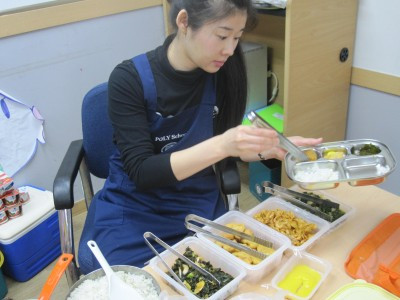
Teacher Jenny dishes up lunch for the preschoolers. This is the same meal Eric is eating in the first picture.
Picnic field trips with preschoolers are fantastic. Instead of PB&Js, they eat kimbap—a popular "fast food" which is almost like sushi roll—except you don't always get sushi. You choose from a variety of fillings (breaded pork, kimchi, vegetables, tuna, ham and egg…) Most Korean mothers prepare this for their kids, or a roll costs between $1-$3 in a local shop. On field trip days, I roam back and forth among miniature lunchboxes, begging handouts. And the side dishes these children pack—they're amazing:imitation crab, roasted shelled walnuts, fresh pineapple, and peaches and watermelon are all accompanied by adorable trainer chopsticks, a bottle of juice, and perhaps some cookies or a small bag of puffed snackage.
珍妮老师正在为学前班儿童配置午餐。这些菜肴与Eric在第一幅图中的菜肴是一样的。
与学龄前儿童一起野餐实在是太棒了,他们吃韩式紫菜包饭而不是花生酱三明治。韩式紫菜包饭是一种流行的“快餐”,几乎像是寿司卷 - 只是不全是寿司,你可以选择许多种食材(炸猪肉,泡菜,蔬菜,金枪鱼,火腿和鸡蛋...)填充进去。大多数韩国母亲为他们的孩子准备的就是这种包饭,或者去当地的商店购买,大约1到3美元一个。在郊游的时候,我在这些小餐盒之间来回漫步,与他们分享美食。这些孩子们带的配菜也是十分令人惊羡的:用漂亮的筷子插好的仿制蟹肉,烤带壳核桃,新鲜菠萝,桃子和西瓜,一瓶果汁,也许还有一些饼干或一小袋膨化食品。
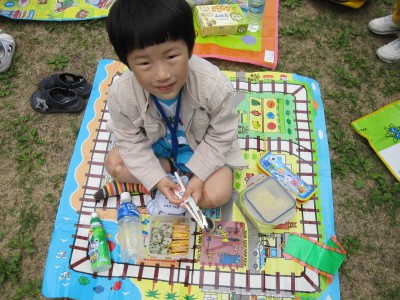
Eddie, chopsticks in hands, gets ready to chow down on some kimbap and spam patties on field trip day.
At the public elementary school, many students have a full 40-minute class period for lunch, sometimes even an hour. Each day they eat rice and kimchi and drink water or white milk. There is often but not always a meat or fish, another vegetable side dish (though it’s rare to eat fresh vegetables here), and sometimes fruit. Occasionally, depending on the school, they get chocolate milk. Today, my third grader told me he ate noodles with black bean sauce, a popular Chinese dish. My middle schoolers say their lunch now is better than before, and for late afternoon study halls they’re served small dinners of noodles and other food. Wednesdays are traditionally “special” lunch days, with rice replaced by another main course.
A recent article and blog about rising child obesity in Korea, cited late-night academies, over-packed schedules, and the prevalence of convenience stores (sodium-heavy ramen, cookies, etc) and greasy street food as culprits. I agree entirely, and point out that in the long run these sacrificial schedules I the name of educational emphasis will backfire if the unhealthy irregular diets start affecting energy and development.
在郊游时,埃迪正拿着筷子准备吃韩式寿司和午餐肉。
在公立小学,很多学生有整整40分钟时间来吃午饭,有时甚至达到一个小时。每一天,他们都吃米饭和泡菜,喝水或者牛奶。他们经常能但并不总是能吃到肉或鱼,蔬菜配菜(虽然在这里很难吃到新鲜蔬菜),有时是水果。学校偶尔会为他们提供巧克力牛奶。今天,我的一个三年级学生告诉我,他吃了豉酱面条,那是一种知名的中国菜。我的一个初中学生说,他们的午餐现在是比以前好些了,傍晚的时候,他们可以在学习室吃到面条等食品作为小晚餐。周三在传统上是“特殊”午餐日,米饭会更换为另一种主食。
最近一些关于韩国儿童肥胖上升的文章和博客,指出夜校,过度利用的时间表,以及便利店的普遍(富含钠的面条,饼干等)和油腻的街头食品是罪魁祸首。我完全同意,同时想指出,从长远来看,如果不健康不规律的饮食开始影响能源和发展,这些被我成为强调教育的而牺牲的时间的恶果将显现出来。
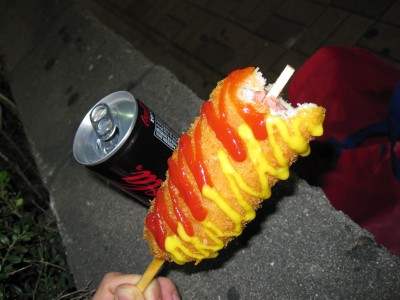
Street food is delicious and convenient, but less than healthy.However, what Korean junk food does typically have on its side is portion size, which is typically half the size of the same “serving” equivalence of a Western snack. For example, pop into the corner “Family Mart” for a can of Coke and you get a slim 250 mL containing 110 calories, instead of the chunky standard 330mL (12oz can) with 155 calories. Bottle sizes are smaller, too.
街头小吃都很美味而且方便,但是不够健康。但是,韩国的垃圾食品在提供份额上有典型特征——通常是西方甜食的一半。比如你走进“全家”便利店里买一罐可乐,你会发现这里提供的是110卡路里250ml的可乐而不是那种包装短粗的含有155卡路里的330ml(每罐12盎司)的那种。瓶子也比较小。
Even some of their junk-food beverages make an attempt to include nutrition value! From aloe juice to "Milkis", a carbonated milk kids' favorite, smaller bottles mean even sweet beverages are toned down. “Pocari Sweat,” a popular drink despite its gag-worthy name, is full of antioxidants and ions that make this vitamin water a healthier alternative. Indeed, it’s one of the most prevalent student-consumed drinks I’ve seen. Now if only they could pair the sweet drinks with fluoride in the tap water. For all the health I'm claiming I still see way too many kids here with mouths of metal, and in Korea that doesn’t mean braces—it means silver fillings!
他们甚至试图在一些高热量的不健康饮料中加入一些营养成分!从芦荟果汁再到一种深受孩子喜爱的碳酸饮料牛奶——“牛奶苏打水”。较小的瓶子甚至意味着糖份被降低了。"宝矿力水特"是一种很流行的饮料,除了那个让人纠结的名字,它实际上还含有抗氧化成分和电解质,这使它成为维他命水中更健康的选择。实际上,这是我所见过的最受学生欢迎的饮料之一。但愿他们能把这些甜甜的饮料和饮用水中的氟化物合理搭配。我说的都是关于健康的。在这里我看到太多的孩子满口金属牙套,并且在韩国这不仅仅意味着对牙齿的一种支撑,它还意味着用银粉填补牙齿!
As South Korea moves from a devastated rural concentration to a tech-savvy, academics-oriented society, it now increasingly faces the same health and nutrition problems as the United States and other countries. So far, it’s still managing to fit its skinny jeans. But as late-night academy hours continue and “American” fastfood lunches become more the norm than the specialty at elementary schools, (and now this kimchi shortage!) will those jeans continue to fit?
韩国从一个满目疮痍的乡村集中的地方发展成一个科技娴熟,以高科技为核心的社会,现在,它逐渐与美国和其他国家一样面对同样的健康和营养问题。到现在为止,韩国仍然能够“穿上”它那紧身的牛仔裤,但是随着在深夜学习的情形的持续,“美式”快餐与本地食物相比变得更加普遍和规范(并且现在泡菜短缺),这些牛仔裤还会合身吗?


